| This article needs additional citations for verification. Please help improve this article by adding citations to reliable sources. Unsourced material may be challenged and removed. Find sources: "City Palace, Potsdam" – news · newspapers · books · scholar · JSTOR (July 2014) (Learn how and when to remove this message) |
| Potsdam City Palace | |
|---|---|
| Potsdamer Stadtschloss | |
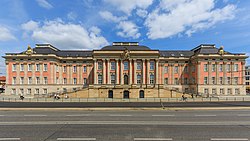 Main facade of the Potsdam City Palace in 2017 Main facade of the Potsdam City Palace in 2017 | |
| General information | |
| Type | Palace |
| Architectural style | Baroque, Rococo |
| Town or city | Potsdam |
| Country | Germany |
| Coordinates | 52°23′38″N 13°03′36″E / 52.394°N 13.060°E / 52.394; 13.060 |
| Construction started | 1662 |
| Completed | 1669 |
| Renovated | 1744–52, 2006–13 (rebuilt) |
| Client | Frederick William, Elector of Brandenburg Frederick II of Prussia State of Brandenburg |
| Design and construction | |
| Architect(s) | Georg Wenzeslaus von Knobelsdorff |
The Potsdam City Palace (German: Potsdamer Stadtschloss) is a building in Potsdam, Germany, located on the Old Market Square, next to the St. Nicholas' Church (Nikolaikirche). It was the second official residence (the winter residence) of the margraves and electors of Brandenburg, later kings in Prussia, kings of Prussia and German emperors.
Heavily damaged in World War II and later dismantled by the East German communist regime, the partial reconstruction, with historic facades and a modern interior, was completed in late 2013. The building has since served to house the parliament of the federal state of Brandenburg.
History
The Baroque palace was constructed on the site of an earlier fortification from 1662 to 1669 under Prince-Elector Friedrich Wilhelm, and was rebuilt from 1744 to 1752 by Georg Wenzeslaus von Knobelsdorff under Friedrich II, who performed additional interior decoration. It stood as one of the most important examples of Frederician Rococo.
During an Allied bombing attack on 14 April 1945 the City Palace was bombed and burned out, although 83 per cent of the building structure survived. However, the ruling communist party (official name: Socialist Unity Party of Germany, SED) demolished the ruin in 1960 for ideological reasons. The formerly cohesive Old Market lost its face. The only portion of the palace left standing was the stables, which today houses the Potsdam Museum of Film.
In 1991 construction of a modern theatre, which had been initially planned under the GDR, began on the site of the City Palace. However, the project stalled. Although some steel framework was erected, it was subsequently torn down.
Reconstruction
After the fall of the Berlin Wall, the ruling Party of Democratic Socialism (the former East German communist SED) twice rejected initiatives to reconstruct the Palace. However, in 1996 strong encouragement was provided by the "Potsdam Project" run by the Summer Academy for Young Architects of the Prince of Wales's London Institute of Architecture. The Project recommended reinstatement of the historical footprint of the Palace via a partial reconstruction.
A Berlin lawyer and real estate entrepreneur, Michael Schöne, who bought and renovated old buildings, was troubled by the wasteland of the site, believing that Potsdam would never work until its core was restored. In 1996 he initiated the first attempt at reconstruction, with the launch of a fund. The vision was that the new palace would be home to galleries, museums and cafes or upstairs apartments and offices. However, opposition from various Potsdam cliques defeated the project and the collected monies were returned to the donors.
However, shortly afterwards the PDS politician Birgit Müller, then chairman of the City Council, agreed to support the reconstruction of the main portal of the Palace, the Fortuna Gate. It was a small window in time, as the PDS would soon officially oppose reconstruction. The SPD under Matthias Platzeck also supported Schöne. In 1996 the City Castle Association was established, with Schöne as chairman. Large donations by the television presenter Günther Jauch and the Federal Association of the German Cement Industry, led by Jürgen Lose, made the rebuilding of the Fortuna Gate possible. It was completed in October 2002. The structure was seen as the bait to encourage rebuilding of the Palace itself, which was still opposed to by the political Left.
In a dramatic night vote, in 2000 the Potsdam City Council voted for reconstruction, but this had real no support at the state level, and at the time there was a recession. When the economy improved, in May 2005 there was agreement that the parliament would relocate from its GDR building to a new parliament building in the external forms of the historic palace. Despite this, the reconstruction still had strong opponents. Rainer Speer of the SPD, then finance minister, repeatedly tried to stop the project.
In 2007 a referendum was held to decide three building options for the remainder of the site. The Left Party was stunned when almost 50 percent of voters turned out (far more than for elections for the European parliament), and voted decisively for reconstruction of the Palace. "It's not what we wanted", the Left Party's parliamentary leader Hans-Jürgen Scharfenberg stated following the vote, "But we'll respect people's decisions".

An architectural competition was launched. The initial plan was for only the principal northern facade to be an historical reconstruction, with the wings and interior modern, and the City Palace Association feared "cost optimised architecture" would dispense with many of the historical elements. Two days before the final meeting of the jury competition, the Prime Minister received a call from software mogul Hasso Plattner offering a donation of €20 million to enable the entire historic facade to be reconstructed – at the time, the largest donation ever gifted in Germany by an individual. Plattner later provided a further large donation to enable the roof to be clad in the original copper. The Palace was completed in late 2013. The interior, which is modern, houses the parliament of the federal state of Brandenburg.
On one of the walls of the Palace there is an inscription "Ceci n'est pas un château" ("This is not a palace"), an allusion to René Magritte's painting The Treachery of Images – "Ceci n'est pas une pipe".
Gallery
-
 The Potsdam City Palace in 1773
The Potsdam City Palace in 1773
-
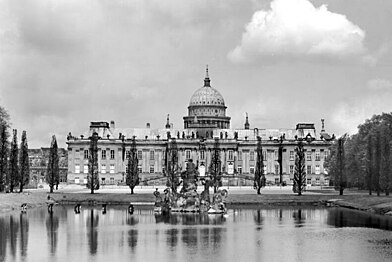 The Potsdam City Palace in 1928
The Potsdam City Palace in 1928
-
 Tea Room, Stadtschloss, Potsdam, 1930
Tea Room, Stadtschloss, Potsdam, 1930
-
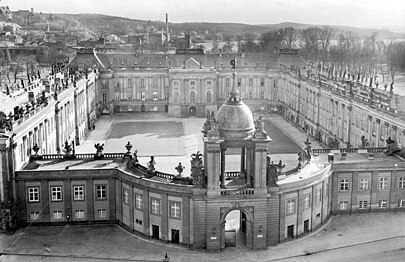 The Palace prior to destruction
The Palace prior to destruction
-
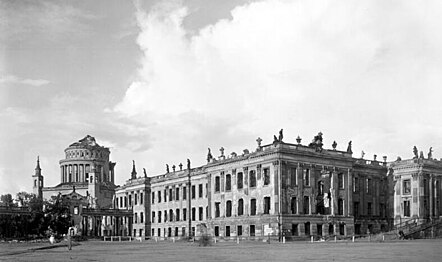 In ruins after World War II
In ruins after World War II
-
 The remaining stables in 2005
The remaining stables in 2005
-
 View over the empty Old Market in 2007 with the reconstructed Fortuna Gate
View over the empty Old Market in 2007 with the reconstructed Fortuna Gate
-
Construction site in 2010
-
Construction site in 2012
-
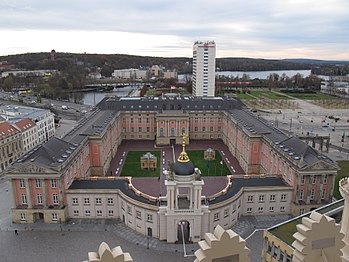 The reconstructed palace in 2016
The reconstructed palace in 2016
-
 City Palace with St. Nicholas Church
City Palace with St. Nicholas Church
See also
References
- ^ "In Surprise Vote, Potsdam Decides to Rebuild Baroque Palace | Culture | DW.COM | 05.01.2007". DW.COM. Retrieved 2015-11-25.
- ^ "Brief history of the new Landtag building: The long road from city palace to Landtag palace", Landtag Brandenburg, 2014. http://www.landtag.brandenburg.de/media_fast/5701/Schriftenreihe_1_2014_englisch.pdf Archived 2016-08-20 at the Wayback Machine
- The Potsdam project, 1996, HRH The Prince of Wales, Charles; Hanson, Brian; Steil, Lucien; Prince of Wales's Urban Design Task Force; Prince of Wales's Institute of Architecture, Prince of Wales's Institute of Architecture, 1998
- ^ Wiechers, Katharina (2016-09-07). "Stadtschloss-Vorkämpfer Michael Schöne blickt zurück: Zwei Jahrzehnte für Knobelsdorff". Potsdamer Neueste Nachrichten. Retrieved 2016-09-12.
- Karutz, Hans-Rüdiger (2000-04-14). "Beton-Spende macht Portal möglich". Welt Online. Retrieved 2016-06-28.
- "Potsdamer Neueste Nachrichten". Archived from the original on 2016-03-17. Retrieved 2014-01-04.
Bibliography
- Schöne, Michael; Boddien, Wilhelm von (2016). Stadt sucht Mitte : Potsdams Weg zum neuen Stadtschloss (in German). Potsdam: Strauss Edition. ISBN 978-3-943713-26-8. OCLC 967151275.
External links
- 'Das Potsdamer Stadtschloss in Gefahr' (1949), historical short movie about Potsdam city palace warning against its demolition.
- Houses completed in 1669
- Houses completed in 1752
- Royal residences in Brandenburg
- Palaces in Brandenburg
- Demolished buildings and structures in Germany
- Baroque architecture in Potsdam
- Rebuilt buildings and structures in Potsdam
- Buildings and structures in Germany destroyed during World War II
- 1669 establishments in the Holy Roman Empire
- German Landtag buildings
